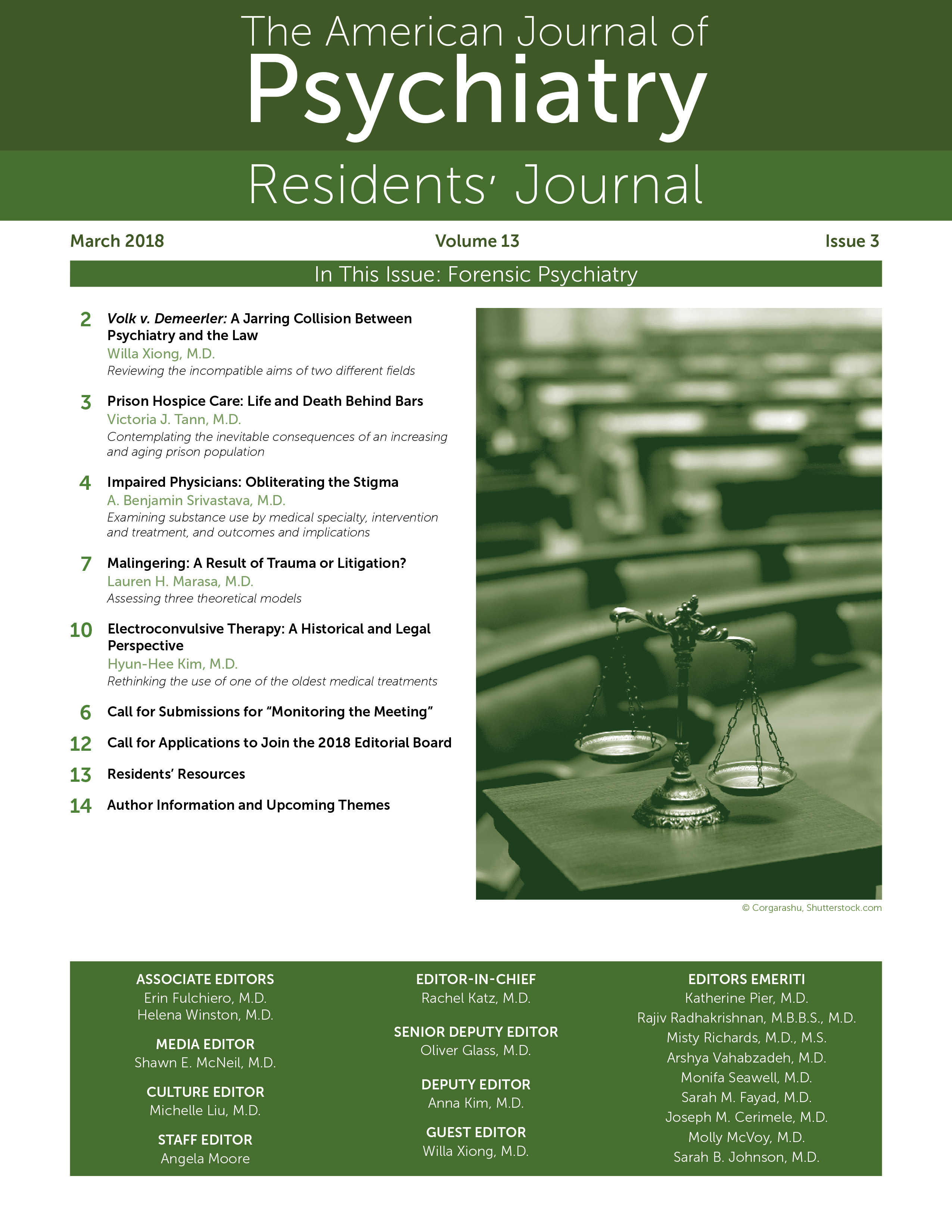Electroconvulsive Therapy: A Historical and Legal Perspective
Electroconvulsive therapy (ECT) is one of the oldest medical treatments still in regular use. First performed in 1938 in Italy, ECT was invented to replace less reliable, more unpleasant methods of inducing seizures (e.g., camphor, insulin-coma therapy) (1).
Until the 1950s, pharmacotherapy for psychiatric disorders was extremely limited. Hence, ECT was applied broadly—for substance abuse, schizophrenia, hysteria, and anxiety. It was even used for homosexuality, which remained a diagnosis in the DSM until 1973. Earlier forms of ECT often caused severe confusion and memory loss, without justifiable accompanying benefits (1). Safety and side-effect concerns have since been addressed by methodological changes, including the use of neuromuscular blockers, sedatives, physiologic monitoring, airway management, dose titration, and varied electrode placements (2). Nevertheless, such historical precedents have contributed to the stigmatization of ECT among the public.
Legislative hurdles have limited the use and availability of ECT, at times resulting in treatment being delayed for weeks while patients await court hearings (1). Unlike most other treatments in medicine, including far more invasive procedures, a health-care power of attorney may not be able to consent to ECT on a patient's behalf (see Table 1). Ten states require court approval if the patient is unable or unwilling to consent (3). Twenty states have specific legislation limiting ECT use, and three have legislation more stringent than APA guidelines (3). For example, in Texas, ECT is banned for use among all patients under age 16, and the state mandates registration of ECT devices and quarterly reports from treating facilities.
| Statute Type | State Plus Mandates and Recommendations |
|---|---|
| More stringent than APA guidelines | California: Three physicians (two board-certified) must agree to treatment and agree that the patient is able to provide consent. |
| Texas: All facilities administering ECT must follow requirements pertaining to the registration of ECT devices and the informed-consent process and submit quarterly reports on all ECT patients. ECT may not be used for patients <16 years old. Two physicians must agree to treatment if the patient is >65 years old. | |
| New York: Extensive guidelines for voluntary ECT in mental hygiene laws. | |
| Specific legislation; involuntary ECT requires court approval | Arkansas, Connecticut, Minnesota, Missouri, New York, Ohio, Pennsylvania, South Dakota, Texas, and Virginia |
| Specific legislation but no explicit requirement for a court order for involuntary ECT | Colorado, Delaware, Illinois, Nebraska, North Carolina, Oregon, Vermont, and Washington |
| No specific legislation (defaults to APA guidelines) | Alabama, Alaska, Arizona, District of Columbia, Florida, Georgia, Hawaii, Idaho, Indiana, Iowa, Kansas, Kentucky, Louisiana, Maine, Maryland, Massachusetts, Michigan, Mississippi, Nevada, New Hampshire, New Jersey, New Mexico, North Dakota, Oklahoma, Puerto Rico, Rhode Island, South Carolina, Tennessee, Utah, Virgin Islands, West Virginia, Wisconsin, and Wyoming |
TABLE 1. Legislation for ECT by State
Such restrictions on ECT stemmed in part from the antipsychiatry and antiauthoritarian movements of the post-World War II era, as well as negative media portrayals (4). These movements brought to the mainstream the ideas that psychiatric illness was a social construct and psychiatrists were agents of the state who enforced societal norms by pathologizing undesirable behaviors (1). By the 1970s, activists seeking to limit psychiatric treatment found that lobotomies and other biological treatments had been largely phased out. ECT and involuntary commitment remained legislative targets within the broader movement for patient rights and deinstitutionalization. Wyatt v. Hardin (1975), Aden v. Younger (1976), Price v. Sheppard (1979), and similar suits mandated additional ECT oversight, mainly from courts, physicians, and hospital directors (5). Since 1978, APA task force reports on ECT have supported the use of ECT for medication-resistant depression, pregnant or elderly patients, and cases necessitating rapid treatment responses. However, ECT is often the treatment of last resort (5). Delaying ECT not only prolongs distressful symptoms, but also contributes to the development of treatment-resistant affective disorders and worsens catatonia, and it can be lethal in malignant catatonia.
With advances in neurobiological research, the line between psychiatry and neurology has become increasingly blurred and there has been a resurgence in the use of ECT. Yet clinicians may still find themselves having to delay safe and effective treatment while awaiting court approval due to outdated, inaccurate perceptions. As a matter of justice and timely access to effective treatment—and with new knowledge—perhaps it is time to revisit these laws that bar much-needed care.
1. : Ethics in electroconvulsive therapy. New York, Routledge, 2004 Google Scholar
2. : The history of electroconvulsive therapy in the United States and its place in American psychiatry: a personal memoir. Compr Psychiatry 1999; 40(3):173–181 Crossref, Google Scholar
3. : Electroconvulsive therapy: administrative codes, legislation, and professional recommendations. J Am Acad Psychiatry Law 2006; 34:406–4011 Google Scholar
4. : Evolution of the antipsychiatry movement into mental health consumerism. Psychiatr Serv 2006; 57(6):863–866 Crossref, Google Scholar
5. : Electroconvulsive and neuromodulation Therapies. Cambridge, United Kingdom, Cambridge University Press, 2009 Crossref, Google Scholar



